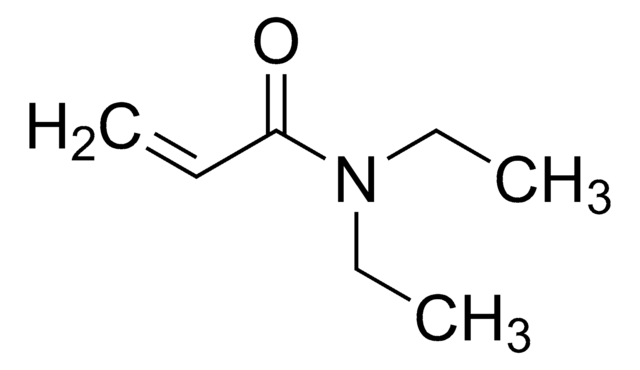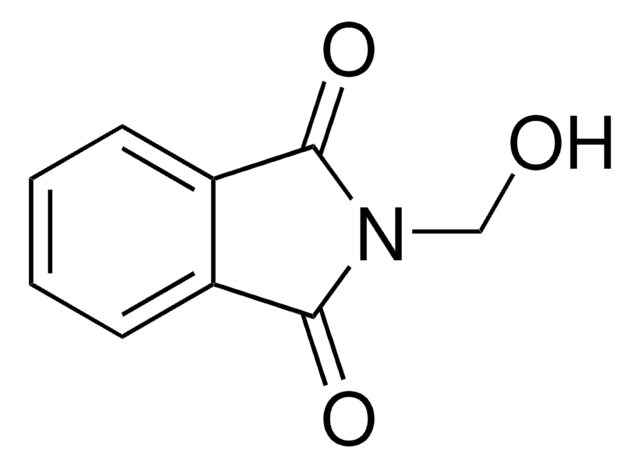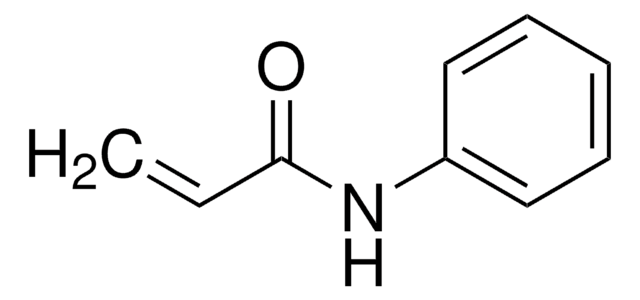245801
N-(Hydroxymethyl)acrylamide solution
48 wt. % in H2O
Synonyme(s) :
Monomethylolacrylamide, N-(Hydroxymethyl)acrylamide, N-Methanolacrylamide
About This Item
Produits recommandés
Forme
liquid
Contient
30 ppm monomethyl ether hydroquinone as inhibitor
Concentration
48 wt. % in H2O
Indice de réfraction
n20/D 1.413
Densité
1.074 g/mL at 25 °C
Chaîne SMILES
OCNC(=O)C=C
InChI
1S/C4H7NO2/c1-2-4(7)5-3-6/h2,6H,1,3H2,(H,5,7)
Clé InChI
CNCOEDDPFOAUMB-UHFFFAOYSA-N
Vous recherchez des produits similaires ? Visite Guide de comparaison des produits
Description générale
Application
- A monomer in the development of polymer gel dosimeters specifically designed for radiation therapy applications. The incorporation of NHMA enhances the sensitivity of the dosimeter to radiation doses.
- A monomer in the development of thermo-responsive polymeric gates, which exhibits thermo-responsive behavior. The incorporation of NHMA enhances the overall properties of the polymer, allowing for better control over the release mechanisms in response to temperature changes.
- A key monomer in the synthesis of double-hydrophilic and amphiphilic block glycopolymers, contributing to their self-assembly properties, biocompatibility, and functionalization potential. These characteristics make NHMA-based glycopolymers valuable for various biomedical applications, including drug delivery systems, biosensors, and tissue engineering.
Mention d'avertissement
Danger
Mentions de danger
Conseils de prudence
Classification des risques
Acute Tox. 3 Oral - Carc. 1B - Muta. 1B - Repr. 2 - Skin Sens. 1 - STOT RE 1 - STOT RE 2 Oral
Organes cibles
Peripheral nervous system
Code de la classe de stockage
6.1D - Non-combustible acute toxic Cat.3 / toxic hazardous materials or hazardous materials causing chronic effects
Classe de danger pour l'eau (WGK)
WGK 3
Point d'éclair (°F)
Not applicable
Point d'éclair (°C)
Not applicable
Équipement de protection individuelle
Eyeshields, Faceshields, Gloves, type ABEK (EN14387) respirator filter
Faites votre choix parmi les versions les plus récentes :
Déjà en possession de ce produit ?
Retrouvez la documentation relative aux produits que vous avez récemment achetés dans la Bibliothèque de documents.
Les clients ont également consulté
Articles
Professor Mitsuhiro Ebara provides insights on several types of smart nanofiber mesh systems that have been explored for different drug delivery purposes.
Notre équipe de scientifiques dispose d'une expérience dans tous les secteurs de la recherche, notamment en sciences de la vie, science des matériaux, synthèse chimique, chromatographie, analyse et dans de nombreux autres domaines..
Contacter notre Service technique



![N-[Tris(hydroxymethyl)methyl]acrylamide contains ≤7% KCl, 93%](/deepweb/assets/sigmaaldrich/product/structures/130/961/5bc6d1a4-a540-4496-9f46-74507af67e21/640/5bc6d1a4-a540-4496-9f46-74507af67e21.png)









